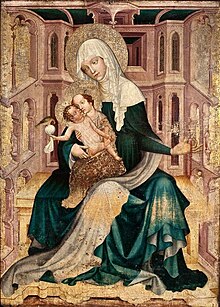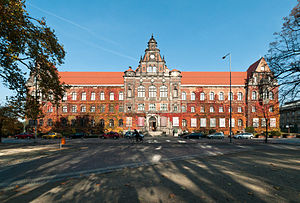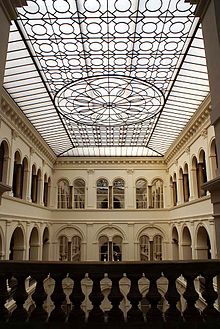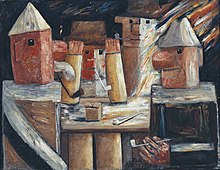National Museum of Wroclaw
The National Museum of Wroclaw ( Polish: Muzeum Narodowe we Wrocławiu ) is a museum of fine arts in the Polish city of Wroclaw (Polish: Wrocław). It emerged from the founding of German museums in the 19th century and from Polish collections in Lemberg and focuses on art from Silesia and Poland. The collection includes around 120,000 objects from the Middle Ages to the present day, including paintings, drawings, prints, sculptures, handicrafts and photographs. The department with works by Polish artists of the 20th century is one of the most important of its kind.
history
German museums until 1945
The long tradition of art museums in Wroclaw began with the establishment of the Royal Museum of Art and Antiquities in 1815. In the rooms of the former Augustinian monastery (today Wroclaw University Library ) on the Sand Island, the museum initially showed works of art that had come into the possession of the state through secularization from churches and monasteries. From this museum the Silesian Museum of Fine Arts emerged in 1880 , which moved into a new building designed by Otto Rathey in the style of late classicism . The Silesian Museum of Applied Arts and Antiquities moved into its own rooms in the former estate in 1899. Both museums existed until 1945 and suffered severe damage to the buildings during World War II , both of which no longer exist today. A large part of the collections of both museums also fell victim to the effects of the war or looting after the war.
From the post-war period to the Polish National Museum
As early as 1947, the now Polish authorities in the city decided to found a new art museum. As their home, they chose the comparatively little damaged former royal government building , which was built between 1883 and 1886 under the direction of Karl Friedrich Endell (1843-1891) in the style of the Dutch Neo-Renaissance . On July 11, 1948, the central art museum for the Silesian region (today's Opole and Lower Silesian Voivodeships ) opened to the public. Only a part of the rescued holdings from the formerly German museums went to the new museum, as other works of art were distributed to art museums in Warsaw, Krakow and Poznan. Instead, holdings from the collections of the former Polish city of Lviv came to the Wroclaw Museum. Since the Polish population of Lviv was mainly settled in Wroclaw as a result of Poland's shift to the west , the museum collections transferred by the Ukrainian authorities were intended to help the residents of their new homeland to identify themselves.
The museum has had the status of a Muzeum Narodowe since November 21, 1970 . Its collections include over 120,000 objects from medieval stone sculptures to photography. The museum mainly shows works by Polish artists, with a focus on artists from Silesia. In addition, it also has a collection of works by foreign artists. The museum has two branches, Panorama von Racławice and Ethnographic Museum, Wroclaw, as well as the four-domed pavilion .
The collection

Art from Silesia and Poland
The museum has one of the largest collections of medieval art in Poland. The oldest objects in the museum's collection come from Silesian churches. Examples of this are a Romanesque tympanum from the 12th century, the grave slab of a Silesian prince of the Piast dynasty and the sarcophagus of Henry IV (Silesia) from the Church of the Holy Cross in Wroclaw . There are also various altarpieces from Wroclaw churches, goldsmith work such as reliquaries , but also guild objects made of tin.
One of the earliest paintings in the museum collection is the 14th century Saint Anne with the Virgin and Child from Strzegom (Striegau). A baptism of Christ can be seen by Bartholomäus Spranger, who is active in Bohemia . The museum also shows numerous works by the Baroque painter Michael Willmann , who was active in Silesia, and a series of portraits from the Polish Baroque (17th – 18th centuries). This department is supplemented by baroque sculptures by Georg Schrötter , Matthias Steinl , Michael Klahr the Elder and Franz Joseph Mangoldt, as well as tapestries and a coin collection. Ceramics and glassware from Silesian factories can also be found in the museum from this period.
The museum owns works by Marcello Bacciarelli , Johann Baptist von Lampi , Jan Rustem and Kazimierz Wojniakowski of the artists working at the court of King Stanislaus II August Poniatowski . One of the most famous works in the museum is the monumental painting The Entry of the Polish Ambassador Count Jerzy Ossolinski into Rome in 1633 by Bernardo Bellotto . This group also includes the artist Franciszek Smuglewicz, who specializes in history painting . Another history painter in the collection is Rafał Hadziewicz . Biedermeier portraits from the Lviv School can be seen by artists such as Jan Maszkowski , Alojzy Reichan and Karol Schweikart . There are also pictures of Romanticism by Piotr Michałowski and Jan Nepomucen Głowacki .
The collection contains larger blocks of works by Artur Grottger and Jan Matejko from the second half of the 19th century . Other Polish artists of this era are Henryk Rodakowski , Wilhelm Leopolski , Wojciech Gerson , Józef Szermentowski , Józef Chełmoński , Juliusz Kossak , Aleksander Gierymski and Maurycy Gottlieb .
Polish painting of the turn of the century with paintings by Jacek Malczewski , Olga Boznańska , Władysław Ślewiński , Stanisław Dębicki , Władysław Podkowiński , Leon Wyczółkowski , Witold Wojtkiewicz , Stanisław Wyspiański , Józef Pankiewicz and Wojciech Weiss represented. There are sculptures from this era by Marceli Guyski , Konstanty Laszczka in the museum. From the period between the two world wars come work the painter Tadeusz Makowski , Stanislaw Ignacy Witkiewicz , Władysław Strzemiński , Olga Boznańska and Henryk Stażewski that time whereas in 1945 with artists like Waldemar Cwenarski , Alina Szapocznikow , Jan. life stone , Tadeusz Kantor and Jerzy Tchórzewski represented is.
Overall, the collection of contemporary Polish artists is one of the most important of its kind. There are surrealist landscapes by Zbigniew Makowski as well as works by Kazimierz Mikulski and Jerzy Nowosielski . Artists like Maria Jarema , Henryk Stażewski and Jerzy Rosołowicz tend to express themselves in geometric forms . Works by artists such as Jan Jaromir Aleksiun , Izabella Gustowska and Natalia LL stand for figurative expressionism . As representatives of contemporary art, works by Jerzy Kalina and Józef Szajna can be seen. The inventory of works by Magdalena Abakanowicz is particularly extensive . Modern glass and ceramic works by Julia Kotarbińska , Rudolf Krzywiec , Krystyna Cybińska , Mieczysław Zdanowicz , Irena Lipska-Zworska and Anna Malicka-Zamorska tie in with the long tradition of the Silesian factories .
Foreign artist
Little of the formerly extensive holdings of the Silesian Museum of Fine Arts has remained in the city of Wroclaw. In addition to considerable war losses and looting, the Polish cultural policy of the post-war period also contributed to this, which wanted to obliterate the traces of Prussian-German culture in Breslau. Thus came parts of the collection in other Polish museums such as the painting The Prussian King Wilhelm I to the sarcophagus of his mother, Queen Louise, in the mausoleum of Charlottenburg by Anton von Werner to the National Museum of Warsaw . Only after 1989 did the authorities rethink and individual works by German artists returned to Wroclaw.
The European painting department dates back to the Renaissance period represented by artists such as Leonardo da Pistoia and Georg Pencz . Johann Michael Rottmayr from Salzburg , Johann Georg Platzer from South Tyrol and Adrian van der Werff from the Netherlands are examples of Baroque work, while the Prussian court painter Antoine Pesne is a typical representative of the Rococo . In addition to the Wroclaw painter Adolf Dressler, there are other romantic artists such as Andreas Achenbach and Ludwig Richter ( shepherds in front of a devotional picture ) in the museum. Other 19th-century German artists on display in the museum include Johann Christian Reinhart , Anselm Feuerbach , Ferdinand Georg Waldmüller and Wilhelm Trübner . While the impressionist Lovis Corinth marks the turn of the century, works by Wassily Kandinsky or a collage by Kurt Schwitters represent modern trends of the 20th century.
literature
- Piotr Łukaszewicz: The Flower of Europe, masterpieces from the National Museum Breslau (Wrocław) Exhibition catalog Wallraf-Richartz-Museum Cologne, Fondation Corboud, Edition Minerva, Wolfratshausen 2006, ISBN 3-938832-08-8 .
- Mariusz Hermansdorfer : Muzeum Narodowe we Wrocławiu 1947-2007 (National Museum Wroclaw 1947-2007): Wrocław: Muzeum Narodowe, 2008 ISBN 9788386766444
Individual evidence
- ↑ Szlaki kulturowe National Museum. Retrieved July 23, 2020 .
Web links
Coordinates: 51 ° 6 ′ 39.6 ″ N , 17 ° 2 ′ 51 ″ E





